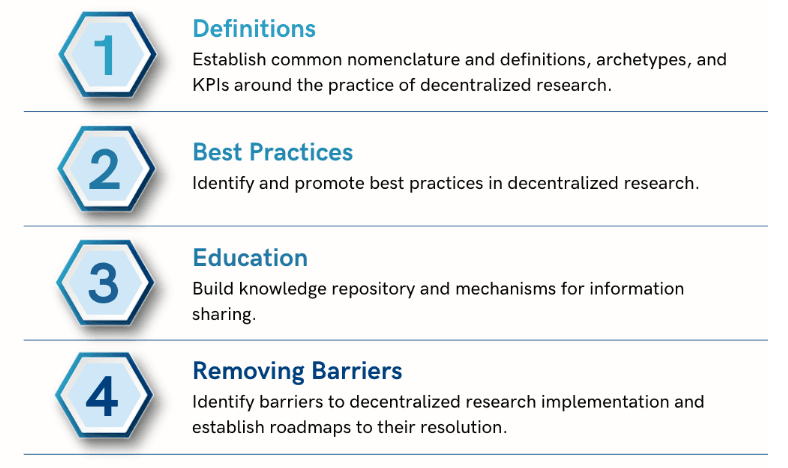
Decentralized Trials & Research Alliance
Interview questions and answers for the Decentralized Trials & Research Alliance (DTRA).

- Can you tell us about the Decentralized Trials & Research Alliance and its purpose?
The Decentralized Trials & Research Alliance (DTRA) was founded in 2020 to create a space for collaboration across stakeholders to ease the global adoption of decentralized research and make research participation more accessible for all.
Planning for DTRA preceded the pandemic following the co-founders finding rich conversation at conference panels about shared challenges but a lack of collaboration space to act on those opportunities. Co-founders Amir Kalali, MD and Craig Lipset began to engage key stakeholders about the creation of DTRA, put some planning on pause during the urgent attention to sustaining trials in the early days of the pandemic lock-downs, and ultimately brought the collaboration to life later that year.
- Your founding members identified 4 priorities: definitions, best practices, education and removing barriers. How do each of these play into the Alliance’s mission and keep everyone focused on achieving the shared mission?

Photo courtesy of DTRA.org
DTRA’s founding members represented a range of diverse stakeholders – pharma and biotech, tech and service providers, CROs and site networks, advocacy groups and government agencies. Yet, despite this diversity the group found substantial common themes to prioritize together and create the foundation for subsequent initiatives.
Definitions address our shared language and removes the noise of a “Tower of Babel” preventing progress due to misunderstanding of terms of key performance measures. Best Practices ensure we can leverage collective intelligence and build upward based on the learnings of our peers. Education helps raise our ecosystem to a higher baseline and ensure we are well-positioned to bring all colleagues along by leveraging evidence of what works. Finally, work to ensure Remaining Barriers in global adoption are understood with pathways for solutions in areas such as regulatory variability or technology interoperability.
- DTRA’s 12 initiatives dive deeper into the organizations process of developing strategic solutions. Explain to our audience how this factors into the work and thought process.
DTRA initiatives are resourced by subject matter experts from across the DTRA community, working together on chartered goals to create solutions meant to raise all organizations. The solutions of each are based upon their respective charter and may differ substantially from a static set of recommendations to a dynamic set of online resources. More details on the status of this work is refreshed at DTRA.org.

Photo courtesy of DTRA.org
- Describe how your stakeholders collaborate in the formation of these decentralized clinical trials and research projects and providing more accessible research approaches.
Each stakeholder in DTRA is free to chart their own path toward decentralized research methods in their organization. Best practices are emerging, including the consistent inclusion of patient voice during design and planning to ensure solutions address true challenges of access. In many cases, different decentralized methods may be required from amongst different vendors and these must work together to provide a seamless option for sites and participants.
- Historically in traditional clinical trials, diverse populations sometimes struggle to gain access while also at times being reluctant to participate. How does DTRA address this issue and bring their work to underserved communities?
All research teams must understand the unique barriers and concerns of the population they wish to engage, and in many cases must invest time to build trust within communities. Decentralized methods then support these efforts by bringing approaches that can mitigate access barriers, such as those requiring time from work, child care or other burden that disproportionately impacts certain populations.
Success here may often mean making options available for participants such as provisioning technology or data access where it may be needed.
- How does your organization work in patient perspectives when mapping care of clinical trial participants, for example, those involved in oncology and rare disease trials?
DTRA’s patient journey initiative team has developed template patient journey maps in key areas such as oncology and rare diseases. These journey maps can serve as a common foundation for study teams considering patient journey, and were specially designed to be cognizant to the unique considerations of patient burden during trial participation.
- Tell us about the consistent themes worked in throughout your education and research. How have they changed and developed along with the work you’ve done over time?
It is still early days, but there remains an important need to understand the evidence associated with the impact of existing decentralized methods. DTRA will soon launch a library meant to feature the range of existing work and publications, as well as tools to help sponsors and others in tracking which studies have incorporated decentralized methods to allow better measurement of impact.
- In November of 2022, DTRA hosted their annual meeting. Tell us about some of the highlights discussed among attendees and how that is shaping your work in 2023 and beyond. What may we see at the 2023 conference?
The DTRA 2022 Annual Meeting focused on the measures being taken to stabilize the core of decentralized research. We featured regulators from three different regions each discussing their work and challenges in stabilizing decentralized research within agencies including expectations of upcoming guidance. We also featured 5 different pharma sponsors each presenting their internal strategies for decentralized research being normalized in their organizations. Several sessions began to explore new and emerging models for research sites and we expect this topic to remain important in 2023 alongside related themes of investigator site oversight and quality assurance.
- Going forward, how do you hope to see this organization grow/what do you still wish to accomplish?
The research ecosystem continues to invest in decentralized approaches for the goals of improving participation (representation, experience, access) as well as resilience (to ensure trial continuity in unpredictable environments). We are also seeing many sponsors incorporating decentralized methods in to their environmental and sustainability goals, as decentralization can help support reduced burden of trials on the planet.
DTRA will evolve to meet the dynamic needs of the research community on the journey to normalizing decentralized methods across all studies. Our shared goal is that we will no longer discuss “decentralized” but that these tools will simply become a part of our process of designing and planning all studies. Ultimately, the vast majority of trials in the portfolio will be able to include some decentralized solutions – some including many or all approaches – and that together we will make research more equitable, accessible, and sustainable.